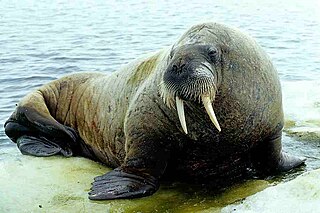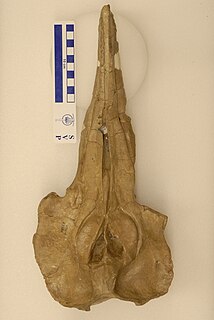
Odobenidae is a family of pinnipeds. The only living species is the walrus. In the past, however, the group was much more diverse, and includes more than a dozen fossil genera.

The walrus is a large flippered marine mammal with a discontinuous distribution about the North Pole in the Arctic Ocean and subarctic seas of the Northern Hemisphere. The walrus is the only living species in the family Odobenidae and genus Odobenus. This species is subdivided into two subspecies: the Atlantic walrus, which lives in the Atlantic Ocean, and the Pacific walrus, which lives in the Pacific Ocean.

An eared seal or otariid or otary is any member of the marine mammal family Otariidae, one of three groupings of pinnipeds. They comprise 15 extant species in seven genera and are commonly known either as sea lions or fur seals, distinct from true seals (phocids) and the walrus (odobenids). Otariids are adapted to a semiaquatic lifestyle, feeding and migrating in the water, but breeding and resting on land or ice. They reside in subpolar, temperate, and equatorial waters throughout the Pacific and Southern Oceans and the southern Indian and Atlantic Oceans. They are conspicuously absent in the north Atlantic.

Baja California Sur, officially the Free and Sovereign State of Baja California Sur, is the second-smallest Mexican state by population and the 31st admitted state of the 32 states which make up the 32 Federal Entities of Mexico. It is also the ninth-largest Mexican state in terms of area.

Caniformia is a suborder within the order Carnivora consisting of "dog-like" carnivorans . They include dogs, bears, wolves, foxes, raccoons, and mustelids. The Pinnipedia are also assigned to this group. The center of diversification for the Caniformia is North America and northern Eurasia. Caniformia stands in contrast to the other suborder of Carnivora, the Feliformia, the center of diversification of which was in Africa and southern Asia.

Enaliarctos is an extinct genus of pinniped, and may represent the ancestor to all pinnipeds. Prior to the discovery of Puijila, the five species in the genus Enaliarctos represented the oldest known pinniped fossils, having been recovered from late Oligocene and early Miocene strata of California and Oregon.

Imagotaria is an extinct monotypic genus of walrus with the sole species Imagotaria downsi. Fossils of Imagotaria are known from the early late Miocene of California.
Megapaloelodus is an extinct genus of birds distantly related to flamingos. It belongs to the same family as the closely related genus Palaelodus, but was more specialized. Megapaloelodus represents a specialization of the lifestyle of Palaelodus, which apparently was more like a wading duck in behavior – long-legged but still able to swim with ease, possibly even diving a lot – than a modern flamingo. Megapaloelodus, on the other hand, seems to have been evolved into a true wading bird, convergent with the true flamingos.
Kentriodon is an extinct genus of toothed whale related to modern-day dolphins. Fossils have been found in Europe, Japan, Korea, and the Western Hemisphere. Seven species have been described so far.

Gomphotaria pugnax was a species of very large shellfish-eating dusignathine walrus found along the coast of what is now California, during the late Miocene. It had four tusks, with one pair in the lower and upper jaws, and according to wear on the tusks, G. pugnax hammered shellfish open, rather than simply sucking them out of their shells as do modern walruses. In terms of the postcranial skeleton, Gomphotaria and other dusignathine walruses were built more like sea lions than modern walrus. Gomphotaria is a prime example of the extreme diversity that walruses once exhibited.

Ontocetus is an extinct genus of walrus, an aquatic carnivoran of the family Odobenidae, endemic to coastal regions of the southern North Sea and the southeastern coastal regions of the U.S. during the Miocene-Pleistocene. It lived from 13.6 mya—300,000 years ago, existing for approximately 13.3 million years.

Scaldicetus is an extinct genus of highly predatory macroraptorial sperm whale. Although widely used for a number of extinct physeterids with primitive dental morphology consisting of enameled teeth, Scaldicetus as generally recognized appears to be a wastebasket taxon filled with more-or-less unrelated primitive sperm whales.
Liolithax is an extinct genus of dolphin from the Middle Miocene (Serravallian) Temblor Formation of California.

Lophocetus is an extinct genus of dolphin belonging to the clade Delphinida that is known from late Miocene (Tortonian) marine deposits in California and Maryland. Although usually placed in Kentriodontidae, recent studies have found it only distantly related to Kentriodon.

Archaeodobenus is an extinct genus of pinniped that lived during the Late Miocene of what is now Japan. It belonged to the Odobenidae family, which is today only represented by the walrus, but was much more diverse in the past, containing at least 16 genera. Unlike the modern walrus, Archaeodobenus did not have tusks but instead had canines of moderate size, and looked more like a sea lion.
Dioplotherium is an extinct genus of mammal known from Neogene deposits in the southeastern United States.
Prototaria is an extinct genus of pinniped that lived approximately 15.97 to 13.65 mya during the Middle Miocene in what is now Japan. It belonged to the family Odobenidae, the only extant species of which is the walrus. Members of the genus Prototaria are believed to be the most basal imagotariine pinnipeds.
Proneotherium is an extinct genus of pinniped that lived approximately 20.43 to 15.97 mya during the Early Miocene in what is now Oregon, U.S.A.. It belonged to the family Odobenidae, the only extant species of which is the walrus.
Kamtschatarctos is an extinct genus of pinniped that lived approximately 15.97 to 11.608 mya during the Early Miocene in the Kavran-Ukhtolok Bay of Russia's Kamchatka Peninsula. It belonged to the family Odobenidae, the only extant species of which is the walrus.


















